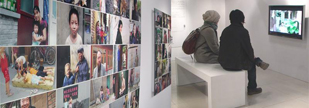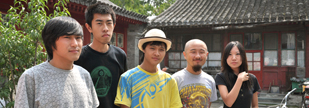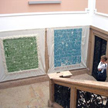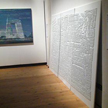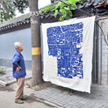|
|
||||||||||||||
与意大利艺术家玛赛拉肯帕 和 斯蒂凡罗阿文桑尼关于北京胡同展览计划的对话 |
||||||||||||||||||||
On Hutong Project,Dialogue between MARCELLA CAMPA, STEFANO AVESANI and Gan Yu |
||||||||||||||||||||
|
Selected Works by MARCELLA CAMPA and STEFANO AVESANI 玛赛拉和斯蒂凡罗作品选
|
||||||||||||||||||||
|
||||||||||||||||||||
|
Photo Images provided by MARCELLA CAMPA and STEFANO AVESANI
|
||||||||||||||||||||
| . | ||||||||||||||||||||
On Hutong Project,Dialogue between MARCELLA CAMPA, STEFANO AVESANI and Gan Yu |
||||||||||||||||||||
| . | ||||||||||||||||||||
I’m glad to chat with you two artists about your Beijing Hutong project. Here are my questions: |
||||||||||||||||||||
| 1. Clearly, these artworks merged themselves with social realities. Is this your main idea that emphasizes the relationship between art and society? | ||||||||||||||||||||
| . | ||||||||||||||||||||
We have been always fascinated by the fact that among the Hutong districts the social aspect is strongly interlaced with the physical and spatial one. The two aspects interact and influence each other and they’ve made unique the relationship of the Hutong environment with the community of people living in it. The whole Instant Hutong project has been inspired by the Hutong community and we look at our works as a way to communicate directly with this community, which we consider an ideal one. |
||||||||||||||||||||
| . | ||||||||||||||||||||
| 2. What is your motivation for exploring hutongs from an artistic perspective? | ||||||||||||||||||||
| . | ||||||||||||||||||||
It is probably our own way to react to the extensive demolitions and the fast pace disappearance of the sense of community and identity. During the Urban Carpet project we spent almost one year on the Hutong lanes creating some temporary happening with the Hutong inhabitants, hanging the carpets on the ropes commonly used by people to typically hang their clothes out to dry. Once a carpet had been hung in the alleys, local people would gather around it, recognizing their neighborhood, pinpointing familiar alleys and telling stories about their own daily life and habits in the Hutong. Each event we organized on the lanes was a chance for surprising encounters, curious face to face interactions and unexpected social adventures. |
||||||||||||||||||||
| . | ||||||||||||||||||||
| 3. How long have you been staying China for exploring art and culture presentations? | ||||||||||||||||||||
| . | ||||||||||||||||||||
We have been in Beijing for four years, coming firstly attracted by an architectural interest, that gradually turned into a social and artistic one. From this point of view, modern China offers a very inspiring environment. On one hand our works record the aspects that catch our curiosity, on the other one they are a tool we use to explore and get deeper into understanding the local culture and habits. With the series of Urban Carpet 8x5 exhibitions, which we organized recently and the last of which will take place on November 7 th, we were taking the chance of organizing this event as a way to let the visitors to be in touch with the Beijing urban culture. Five “siheyuan” courtyards were selected as location for the five exhibitions, each one representing a different way to live in downtown Beijing today. |
||||||||||||||||||||
| . | ||||||||||||||||||||
| 4. Similar trends have been seen in Italy, as historic neighborhoods and architecture are now an indispensible part of modern Italy. Are there significant lessons that Beijing can learn from Italy in protecting and integrating its past with its future? | ||||||||||||||||||||
| . | ||||||||||||||||||||
There are actually some similarities to trace between what happened in Italy and what is happening in China, although there are of course several striking differences to mark, such the size of phenomena, speed of economic development, political and cultural context. The idea itself of preservation has in Italy and in China a completely different history, so the meaning given to this word is different in the two countries. In a time of fast modernization the risk is to identify the “old” with something that must be thrown away and carelessly be changed or replaced. People in Italy live in 800 years old houses which have been upgraded with modern facilities, and we all think that this mix of old and new is a primary worth for the contemporary Italian urban landscape. New urbanization in many cases doesn’t offer the same richness in terms of human relations, proximity of services (mainly reachable by walk or by bike) and sense of identity, as the traditional districts. Furthermore demolishing your own past means refusing a knowledge which is a result of a living practice. It is not just a question of nostalgia but much more a question of richness in life. |
||||||||||||||||||||
| . | ||||||||||||||||||||
| 5. Do you believe recent transformation process of urban Hotong is beneficial to cultural preservation in the long-term and is this preservation sustainable? | ||||||||||||||||||||
| . | ||||||||||||||||||||
Generally speaking we are much more interested in keeping alive that specific aspect of vibrant social sustainability, than in preserving the decorative elements of the old buildings. In Beijing downtown many courtyards have been renovated in the past few years, the former dwellers have been moved to the outskirts and the density of the district has been lowered down. Beside the fact that many new fake decorations have been added to make them look more traditional, the real risk is to turn the city center into a dead museum. On the other hand, in several areas of Beijing some new functions, such bars shops and other facilities, have been inserted along some Hutongs generating a process of self renovation that made those areas more attractive. These examples demonstrate that the old districts can still offer a high level of flexibility and have the capability to host and express contemporary values. |
||||||||||||||||||||
| . | ||||||||||||||||||||
| 6. What upcoming projects do you have planned? | ||||||||||||||||||||
| . | ||||||||||||||||||||
| We are now working on the final events for URBAN CARPET 8x5 exhibitions, meanwhile preparing some new installations as part of the Instant Hutong project. We also are planning to have an event in cooperation with the design magazine Abitare China and an exhibition showing our works in Italy next spring. At the same time we’d like to stay in touch with the community of Xiang Yu Kou district, which is south of Qian Men in Beijing, organizing a project inside an Hutong area with the participation of the local people. Our long term project is to develop an urban strategy for downtown Beijing planning a sustainable way for the Hutong Areas. | ||||||||||||||||||||
| . | ||||||||||||||||||||
| Thank you very much indeed !I will recommend our audiences to visit www.instanthutong.com | ||||||||||||||||||||
| . | ||||||||||||||||||||
| Xiexie nin! | ||||||||||||||||||||
| . | ||||||||||||||||||||
| Gan Yu, eChinaArt.com | ||||||||||||||||||||
| Please note: From Nov 14 to 27, eight pieces of URBAN CARPET 都市地毯 are on display in Sanlitun Dong Er Jie, Beijing 北京市三里屯东二街2号. Please click here to visit. | ||||||||||||||||||||
| . | ||||||||||||||||||||
与意大利艺术家MARCELLA CAMPA and STEFANO AVESANI关于北京胡同展览计划的对话 |
||||||||||||||||||||
很高兴与二位艺术家交谈关于你们北京“瞬间胡同”和“都市地毯”8X5展览计划的创作体会。下面是我的几亇问题: 1.这些作品很明显地把自己融于社会环境之中。强调艺术与社会的相互联系这是否你们这个展览计划的主导思想? 答:我们一直对胡同区内居民们之间那种特有的社会生活空间和物质生活空间相互交织所形成的文化现象很感兴趣。这些现象相互影响和依存,形成一种别开生面的胡同社区生活环境与人际关系。我们的整个“瞬间胡同Instant Hutong Project”展览计划是受到了这种特殊的社区文化的启发而形成。我们把自己的作品看作是一种与胡同社区居民直接沟的理想渠道。 2.你们以在胡同社区内实地展示艺术作品的方式来探索和表达对北京胡同文化的理解,从艺术的视点出发,你们的原动力是什么? 答:这是我们对正在加速消失的胡同社区及胡同文化的一种自己的反应和做法。在制做以胡同社区为主题的“都市地毯UrbanCarpet”项目时,我们花了将近一年的时间往返于胡同的巷子之间进行调研并制作了一些临时性的,以胡同住区地标为题材的织挂作品。我们以胡同居民在四合院户外凉衣物的方式将作品的两头用绳子挂在竹竿或树枝上。每当这些作品被挂在巷子里展示时,当地居民就会围拢过来观看,指认出他们自己的邻里和所熟悉的街巷并讲述一些他们在胡同里的日常生活逸事。我们在每一亇不同巷子里的展示项目都能给那里的观众带来惊喜, 3.你们在中国进行艺术及文化方面的研究和展览己有多长时了? 答:我们己在北京住了四年。起初仅仅是对这里的建筑感兴趣,以后逐渐扩展到对社会与艺术层面的探索。从这亇观点看,现代中国向世界提供了极富启迪的环境。一方面,我们的作品表露了作者对陌生文化的好奇心;另一方面,它们又是我们去探索和深入挖掘研究地方文化和及生活方式的工具。在我们(9月19日至11月7日)组办的“都市地毯Urban Carpet” 8 x 5系列展览项目里,我们试着让观众触摸北京的都市文化。我们选择了五个四合院作为展览地点,它们每一个都代表着北京现代城市生活的不同特征。 4.关于传统文化保护与现代社会发展方面的相同情形在意大利也可见到。在利大意,一些历史遣留下来的老街坊和古建筑己与现代意大利社会的经济与文化发展长相得益彰,它们成为当今意大利社会生活与文化生活不可缺少的一个部分。请问这种模式是否对北京胡同文化的继承与发展有重要的借鉴意义? 答:虽然这两个国家之间的自然规模、经济发展速度、政治状况以及文化内涵都有明显的区别,利大意与中国之间在从传统到现代文化迁移过程中的确有许多相似之处。单从保护文化遗产的思路上讲,中国与意大利有着完全不同的历史。所以这亇单词(保护)在两个国家有着不同的解释。在高速现代化发展的时代,关键是要把握好什么是必须推倒重建的旧东西和什么是不能够轻意被毁掉的传统文化遣迹之间的分寸。当今的利大意人生活在内含现代化设施的800年以前造的老房子里,我们都认为这种新老结合的做法成功地造就了当代意大利的都市景观。许多例子显示,新的都市化进程不一定会带来从前社区里人们之间的那种亲和关系、方便的服务设施(步行或骑车就可及)和传统的个性意识。况且,摧毁你自己的过去就意味着拒绝接受从实践中得来的生活知识。这不仅仅是怀旧泥古的问题,更应该是关于如何完善现代人们丰富生活品质的思考。 5.你们是否认为现代都市胡同的发展与变迁,从长远的角度看对保护其特殊的传统文化价值有益?这种保护在今后是否能长期有效? 答:总的说来,与保护旧建筑物的装饰性功能或纪念意义相比,我们的兴趣更多地投入在对人们现实生活和社会发展持续性方面的观注。在北京市区,过去几年里有许多四合院被重新整修,以前的住户被迁往市郊,这些区的人口密集度也下降了。除了许多生搬硬套的仿传统建筑装饰外、真正的问题是把市中心区改变为一座无声息的博物馆。另一方面,北京的许多胡同区出现了不少洒吧及商场,这些新型设施的介入使得胡同自觉地进行修整,让该地区变得更加吸引人。这些例子表述出老旧城区同样有能力高度灵活地容纳、兼收与表现人类现代化生活的价值观念。 6. 你们下一步的创作计划是什么? 我们现在正为“都市地毯”8X5的最后一个展览计划而忙碌,同时也在准备一些新的装饰作品。这些作品亦是“瞬间胡同”总策划的一个部分。我们还与设计杂志Abitare China共同筹办于明年春天在意大利举行的作品展览。与此同时,我们正在和北京的地方政府联系争取在前门以南地区的胡同内组织一次邀清当地居民一同参与的作品展出活动。我们的长期计划是发展出一套对北京市区的胡同得以持久生存的可行策略。 谢谢! |
||||||||||||||||||||
Background Info 背景资料 |
||||||||||||||||||||
MARCELLA CAMPA和STEFANO AVESANI从2003年起,致力于中国大城市的发展。2005年他们在国际性的杂志AREA第78期合作编辑了关于中国当代视觉艺术和建筑的论著。因为合作关于北京中心和上海历史性的城区双方协调的项目,他们曾经获得在苏格兰的格拉斯哥的国际性的建筑大奖。2005年10月搬到中国,开始“瞬间胡同”项目。自2007年起,陆续参加了中国和国外的几个展览。现在Marcella和Stefano工作和生活在北京。 |
||||||||||||||||||||
瞬间胡同
“瞬间胡同”是一个艺术项目,是为了纪录和引起关注于那些在建筑发展中面临危机的传统形式中的四合院和小巷。作品在空间和社会性方面探讨了传统胡同的社会性结构和住在这一城市性结构社区中的人们。他们组织的一系列艺术作品和装置作品涉及了艺术,社会调查和城市研究的边界,目的是引起和激发开放的讨论。目前的作品涉及了密集性,住宅开发,人际关系和立体的物理空间,也包括房地产的投机生意以及社区感,身份的的迅速消失。这些话题通过社会领域和美学领域的结合来表达。过去北京的四合院是在胡同社区不断地延伸的,每个房子被一连串的四合院组成,四合院的空间适合了不同历史时期的变化。在过去的60年,遵守分配住房的计划,原来一个单一的家庭的房子被分配给几个核心家庭。因为生活状况的变化,在胡同社区发展出非凡的住宅新概念。独特的密集性,适应变化性,社区的人际关系和一个“面向街道”的生活方式。在最近大范围的拆迁以后,胡同文化当前面临被破坏的危机。“瞬间胡同”的项目是为了让人关注和意识到这种独特的文化,并提供看胡同社区的新方式,同时积极的推动住在胡同的人的参加此项目和在项目中的互动性。 都市地毯 “都市地毯”是“瞬间胡同”项目的一部分,包括八个用手工绘制的地毯和几个短期的在胡同的小巷中举行的活动。每个地毯表示胡同地区的地图,面积大约一平方公里。人口是3万人。这些地区是被隔离在大城市之外的,自诩“自治的城镇”。从中国政府得到这些胡同的细节地图真的不是容易事。前期的研究工作对于任务的发展事非常重要的。严谨的工作是用手工反复仔细的绘制社区地图,这些地图重新诠释了空间质地,而且采用了70年代宣传挂毯的同样的绘制技术,用毛的纹路来精心的绣制。每个地毯跟一系列的城市化行为有关。开始于2009年的春天,这些用于探索的装置作品是挂在绳子,金属丝,线和人们常用的晾干衣服的支撑物上的地毯。从前有张地毯在小巷挂出去以后,居民在地毯周围围观,也在地图中识别他们的社区,指出熟悉的小巷,谈论自己日常的生活和习惯。这是首次大部分本地人有机会观察自己社区的大规模的俯视地图。兴奋于观察和比较现实中的地图和通过日复一日的经验和感知而来的精神的地图。每个活动都会有惊喜,惊奇于面对面的人际关系和无可预期的社会经历。老的独特的社区的特点是行人,这很符合这一展览的互动性。展览的独特性和城市化又再现了胡同本身无秩序的社会结构。 都市地毯8x5 首次,从未曾有过的,我们将把八个都市的地毯放在同一个空间展出。这五个展览将遍及五个四合院,作为当代老北京不同生活方式的简介。每个活动为期一天,在地毯,环境和参与者的互动中带给人独特的感觉。 |
||||||||||||||||||||
| 一 秦唐府7号院 - 北京市东城区前鼓楼苑胡同7号,2009年9月19日
7号院是把老四合院再修复的让人引起联想的例子。把当代的先进技术,象太阳能设备,地源热泵,安装在传统的胡同建筑的布局中,以便于取暖,空调和热水。古老的空间的感觉依然保存,但是住宅的作用以被宾馆所取代。 |
||||||||||||||||||||
二 里九外七 - 北京市西城区西安门大街光明胡同互助巷8号,2009年10月14日
北京的四合院有强烈的本地史和传统,因此更多的选择密集性的文化活动作为平台。举行第二个展览的地点在象一个迷宫一样的胡同的中心,一定值得去的。之所以选择作为里九外七项目的场所,是完美的戏剧性的环境以及可以举行专题研讨会和现代演出。 |
||||||||||||||||||||
| 三 AND-HOUSE - 北京市东城区南锣鼓巷帽儿胡同14号,2009年10月17日
一组年轻的北京人最近占用这个院子把它作为时尚,艺术,音乐,设计和滑板运动的文化中心。近似于最新的“亚文化圈”,处理了与古代建筑产生的不能预期的结合。他们的方式描绘了典型的北京习俗,融合和协调了老和新的东西。 |
||||||||||||||||||||
| 四 社区庭院 - 北京市崇文区鲜鱼口地区草厂头条17号,2009年10月25日
完美地体现了源于近几年北京郊区在不知所措地迅速变化中的矛盾。房地产政策的目的是鲜鱼口社区原住民的再次回归。对城市的传统性的描述都不适合鲜鱼口,当前是特别有趣的城乡结合。城镇的空间和自然的空间,农村的习惯和现代设备的结合,细微地体现于北京的都市中心。 |
||||||||||||||||||||
五 私人地住宅院子 - 北京市西城区鼓楼西大街诸钟胡同56号,2009年11月7日 四角形的房子在这种房子体现出古代住宅如何提供高质量的现代避难所。在过去的50年,北京的四合院展现了适应不同生活方式的结构和在变化的时期中的需求。尽情地享受迷人的家庭的亲密性和神秘的花园,但是记住:勿踏草地。 |
||||||||||||||||||||
。
|
||||||||||||||||||||
All images and text © the authors MARCELLA CAMPA and STEFANO AVESANI
MARCELLA CAMPA and STEFANO AVESANI have been interested in the urban growth of Chinese cities and their transformation since 2003. In 2005 they co-edited the n.78 monographic issue of the international magazine AREA about Chinese contemporary visual art and architecture. They have been awarded with the international Archiprix prize in Glasgow for a double coordinated project for historical districts in downtown Beijing and Shanghai. They moved to China in October 2005 and started working on the Instant Hutong project. Since 2007 their work took part in several exhibitions in China and abroad. Marcella and Stefano currently live and work in Beijing. Instant Hutong is an art project created to record as well as draw people’s attention onto traditional patterns of neighbourhoods, courtyards and lanes in Beijing, all of which are threatened by construction development. This work explores both spatial and social aspects of the traditional Hutong urban tissue and the community of people living in it. It is organized as a series of art pieces and installations on the border between art, social investigation and urban research with the aim of generating and stimulating an open debate. The work currently involves issues such as density, gentrification, human relationships and the concept of physical space, as well as property speculation and the fast pace disappearance of the sense of community and identity. These issues are expressed through merging the social sphere with the aesthetic one. |
||||||||||||||||||||
|
|
||||||||
本网站里所有网页设计的版权属纽约"中华文化艺术网" eChinaArt.com, Inc. 所有,文章、艺术作品照片版权属艺术家或作者本人所有。任何未经版权所有人许可的转载, 出版或借用都将被追究法律责任。eChinaArt.com,Inc© |
||||||||
